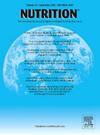Relationship of phase angle with postoperative pneumonia and survival prognosis in patients with esophageal cancer: A retrospective cohort study
IF 3.2
3区 医学
Q2 NUTRITION & DIETETICS
引用次数: 0
Abstract
Objectives
Phase angle (PhA), derived from bioelectrical impedance analysis (BIA), is an indicator of cell membrane health. Low PhA values reflect poor cellular function and low muscle mass. However, consensus regarding the appropriate cutoff value of PhA remains insufficient, and its impact on outcomes after esophagectomy in patients with esophageal malignancies is not well studied. We aimed to investigate whether preoperative PhA is associated with postoperative complication risk and survival prognosis and whether PhA decrease during the surgical preparation period is a prognostic factor in patients with esophageal cancer.
Methods
This retrospective cohort study analyzed data from 194 patients who had undergone esophagectomy for esophageal malignancies. A PhA measured several days before surgery, with cutoff values of 5.0° for men and 4.2° for women, was used. The relationship between postoperative pneumonia and clinicopathological factors and between low PhA and postoperative outcomes and survival prognosis was investigated. The preoperative PhA decline and survival prognosis were analyzed in 134 patients whose PhA was measured twice before surgery.
Results
Overall, 93 and 101 patients were classified into the low and high PhA groups, respectively. A multivariate analysis showed that a serum albumin level lower than 3.5 g/dL and low PhA were independent risk factors for pneumonia (odds ratio [OR] = 3.40, P = 0.03; OR = 3.42, P = 0.03, respectively). The low PhA group exhibited significantly higher intraoperative fluid balance (6.7 versus 6.0 mL/kg/h, P = 0.01) and a higher proportion of patients who failed to achieve early mobilization on the first postoperative day (46 versus 32%, P = 0.04) than did the high PhA group. Multivariate analysis using a Cox proportional hazards model revealed that low PhA was a poor survival prognostic factor, independent of the clinical stage of esophageal cancer (hazard ratio = 2.61, P < 0.01). In patients whose PhA was measured twice preoperatively, a decrease in PhA during the preoperative period was a significant indicator of poor survival (hazard ratio = 2.59, P < 0.01). The group with a decrease in PhA during the preoperative period had significantly fewer steps than the group with an increase in PhA (6220 ± 2880 versus 8200 ± 2850, P < 0.01).
Conclusions
Low PhA was a risk factor for postoperative pneumonia in patients who had undergone esophagectomy and was associated with poor survival prognosis. A decrease in PhA during the preoperative period was a significant poor prognostic factor. Increasing physical activity before surgery may lead to an increase in PhA. Thus, it is important to measure and evaluate PhA changes sequentially in patients with esophageal cancer.

食管癌患者相位角与术后肺炎及生存预后的关系:一项回顾性队列研究
目的由生物电阻抗分析(BIA)导出的相位角(PhA)是细胞膜健康状况的一个指标。PhA值低反映细胞功能差和肌肉质量低。然而,关于PhA的适当临界值仍未达成共识,其对食管恶性肿瘤患者食管切除术后预后的影响也未得到充分研究。我们的目的是探讨术前PhA是否与术后并发症风险和生存预后相关,以及手术准备期PhA减少是否是食管癌患者预后的一个因素。方法回顾性队列研究分析194例因食管恶性肿瘤行食管切除术的患者资料。在手术前几天测量PhA,临界值为男性5.0°,女性4.2°。探讨术后肺炎与临床病理因素、低PhA与术后结局及生存预后的关系。分析134例术前两次测定PhA的患者术前PhA下降情况及生存预后。结果共分为低PhA组93例,高PhA组101例。多因素分析显示,血清白蛋白水平低于3.5 g/dL和低PhA是肺炎的独立危险因素(优势比[OR] = 3.40, P = 0.03;OR = 3.42, P = 0.03)。低PhA组术中液体平衡明显高于高PhA组(6.7 mL/kg/h vs 6.0 mL/kg/h, P = 0.01),术后第一天未能实现早期活动的患者比例也高于高PhA组(46% vs 32%, P = 0.04)。Cox比例风险模型的多因素分析显示,低PhA是一个不良的生存预后因素,与食管癌的临床分期无关(风险比= 2.61,P <;0.01)。术前两次测定PhA的患者,术前PhA降低是生存不良的重要指标(风险比= 2.59,P <;0.01)。术前PhA减少组的步数明显少于PhA增加组(6220±2880 vs 8200±2850,P <;0.01)。结论慢PhA是食管切除术患者术后肺炎的危险因素,并与不良的生存预后相关。术前PhA降低是影响预后的重要因素。术前增加体力活动可能导致PhA增加。因此,依次测量和评价食管癌患者PhA的变化具有重要意义。
本文章由计算机程序翻译,如有差异,请以英文原文为准。
求助全文
约1分钟内获得全文
求助全文
来源期刊

Nutrition
医学-营养学
CiteScore
7.80
自引率
2.30%
发文量
300
审稿时长
60 days
期刊介绍:
Nutrition has an open access mirror journal Nutrition: X, sharing the same aims and scope, editorial team, submission system and rigorous peer review.
Founded by Michael M. Meguid in the early 1980''s, Nutrition presents advances in nutrition research and science, informs its readers on new and advancing technologies and data in clinical nutrition practice, encourages the application of outcomes research and meta-analyses to problems in patient-related nutrition; and seeks to help clarify and set the research, policy and practice agenda for nutrition science to enhance human well-being in the years ahead.
 求助内容:
求助内容: 应助结果提醒方式:
应助结果提醒方式:


